ALIEN HUNGER: MORE FUN THAN SCARY
by Thomas M. Sipos, managing editor [July 15, 2014]
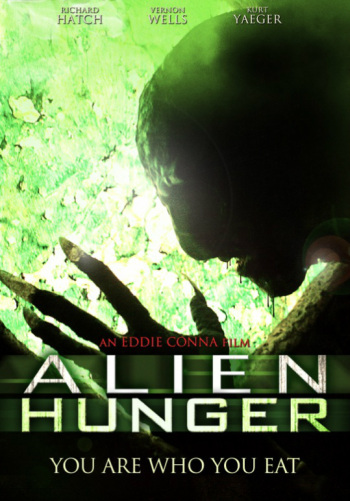 [HollywoodInvestigator.com] Two kinds of aliens populate horror films. Those that make for smart, creepy, conspiratorial tales with a plausible basis in science (e.g., The X-Files, Invasion of the Body Snatchers). And those that are mindless, rampaging, and often silly monsters whose scientific plausibility is nil. They could as easily be flesh-eating zombies or nuclear mutants and it wouldn't change the story. [HollywoodInvestigator.com] Two kinds of aliens populate horror films. Those that make for smart, creepy, conspiratorial tales with a plausible basis in science (e.g., The X-Files, Invasion of the Body Snatchers). And those that are mindless, rampaging, and often silly monsters whose scientific plausibility is nil. They could as easily be flesh-eating zombies or nuclear mutants and it wouldn't change the story.
Silly monster aliens are more common as it's easier to build goofy rubber suits than an atmosphere of subtle creepiness. Alien Hunger walks the broad and easy path, contributing yet another silly monster to horror's alien villains. It's a stupid film, but like the bug-eyed monster movies of the 1950s, it's stupid fun.
The film opens with a spacecraft landing in the California woods, releasing an alien ... and the body count mounts. Yes, these aliens flew an awfully long distance for a killing spree, but there is a rationale. These aliens eat people, so one can surmise that their world is running out of food. Good thing they found a planet that meets their dietary needs.
After an initial feeding frenzy upon bikers, hunters, and campers -- the human prey is whittled down to seven people trapped inside a cabin with the flesh-eating aliens outside. Naturally, the humans are a disparate bunch, arguing among themselves as they plan their escape.
"Alien Hunger is a cross between old style 1950s monster matinee flicks and horror films of today, but with more tongue-in-cheek," said writer/director Edward Conna to the Hollywood Investigator. "With the tag line 'You are who you eat,' you can't take this film too seriously.
"I have always loved science fiction and monster movies. Some of my favorites are Alien, Predator, and The Thing. I would love to make those type of serious movies. But we did not have the budget to take ourselves too seriously. When I wrote the script, I took the budget into consideration."
Alien Hunger's humor is mostly dialog-based. Characters are always tossing quips and barbs at each other, sometime playful, sometimes spiteful. This is both good and bad. Some lines are funny. But the two leads (Vernon Wells and Richard Hatch) overdo it. Seemingly incapable of talking to each other absent witty banter, their comedy act begins to annoy. Even as they approach the deadly alien pod, they're still joshing back and forth, Wells grinning at his own jokes.
"Some of Richard and Vernon's banter was ad-libbing," said Conna. "They became fast friends on the set and some of their banter found its way into the performances. The comedy was already in the script, but they took liberties and ran with it."
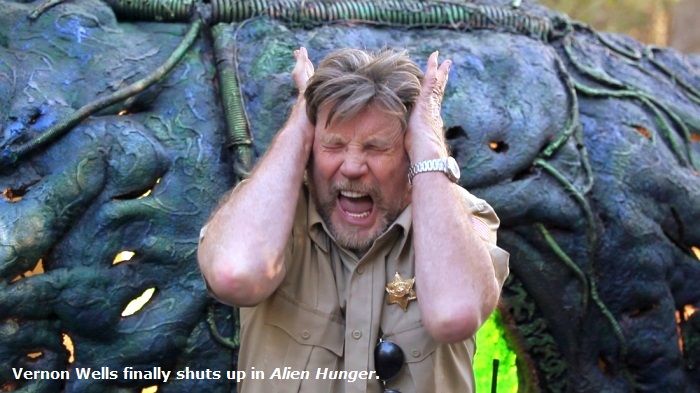
Because Alien Hunger seeks fun thrills rather than a creepy atmosphere, the banter is not a huge problem (though I was glad when Wells was finally killed and forced to shut up). And the film does have thrills. The aliens move fast, making for some exciting chases. Stunt work is better than what one expects from an indie movie. Cars crash against trees, plunge into a lake, plow through an RV. Alien Hunger rarely terrifies, but it also rarely bores. Low on atmosphere and creeps, but high on action and suspense.
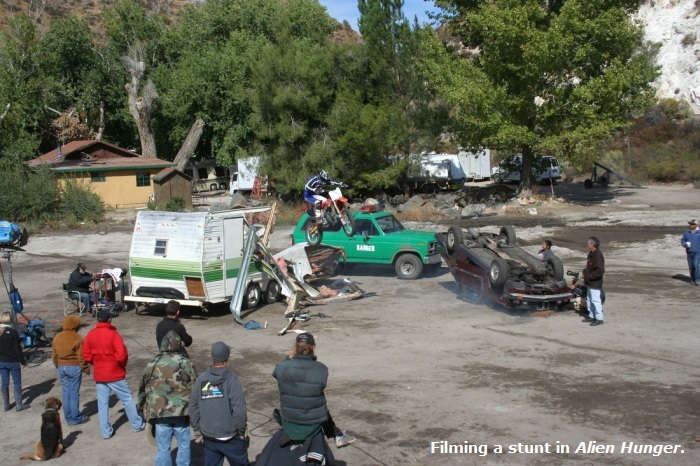
"Most of my film career has been in stunts," said Conna. "I have the connections to pull off action sequences. I had worked with almost everyone on the film on some previous project. We looked for people who could pull off a shorter shooting schedule with a good attitude. Most of our days were 12 hours or less. You have to treat your crew with respect."
Alien Hunger's heavy use of background music further heightens suspense and quickens the pace.
As in many horror films, characters are broadly drawn. Of the three women trapped in the cabin, there's a selfish bitch, a courageous fighter, and a maternal healer. There's also a good boy, an angry boy, and Wells and Hatch as the sheriff and park ranger.
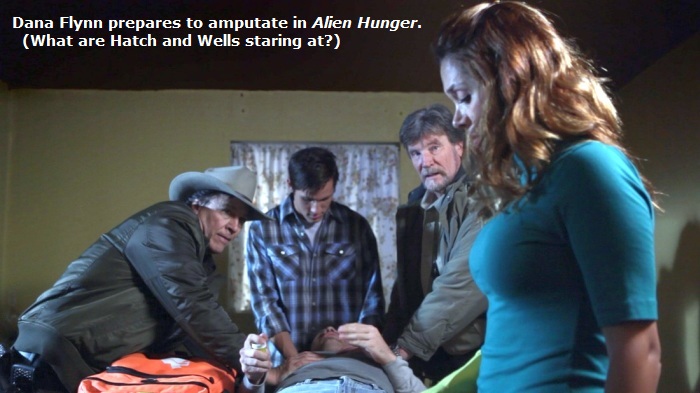
Despite the stereotypes, characters do occasionally display some refreshing originality. The angry boy (Kurt Yaeger) shows surprising spunk when his leg must be amputated, throwing snarky one-liners rather than shrieking in fear, as is often the case with second bananas.
Vernon and Wells are surprisingly selfish in refusing to enter a lake to save two girls under attack. They instead scream warnings and encouragement from the shore. Their explanation, that they've seen these aliens in action and couldn't save the girls if they tried, is true but unexpected. Police heroes in movies rarely opt for cautious cowardice over foolhardy bravery. One girl survives and spends the rest of the film bitchy and angry about being left to die, and shows no interest in helping others. Well, she has a point.
Unlike many indie movies, Alien Hunger was filmed in California rather than in cheaper out-of-state locations. "It didn't make sense to shoot outside of California when our assets and connections are in California," said Conna. "We saved money on travel, hotels, per diem, etc. It was easy to pick up expendables for the shoot. If we needed to get a piece of equipment, a runner could get it back to set in hours.

"Obtaining a Los Angeles permit can be a challenge. Many filmmakers that stay in California shoot outside of Los Angeles, in areas like Kern County, Ventura County, etc. because the film permit costs and hassles are less."
The California location and car stunts are less impressive when one realizes that Alien Hunger isn't all that low-budget. Conna says he spent around a million dollars. "We found multiple investors who put in various amounts of money to divide the risk. We worked hard to put every penny on screen. A film's budget doesn't matter in the end. What matters is what's on screen and what the final product earns.
"My background in the stunt world has given me a lot of connections and insight into where to spend money and where not to. We did things safely, but within budget."
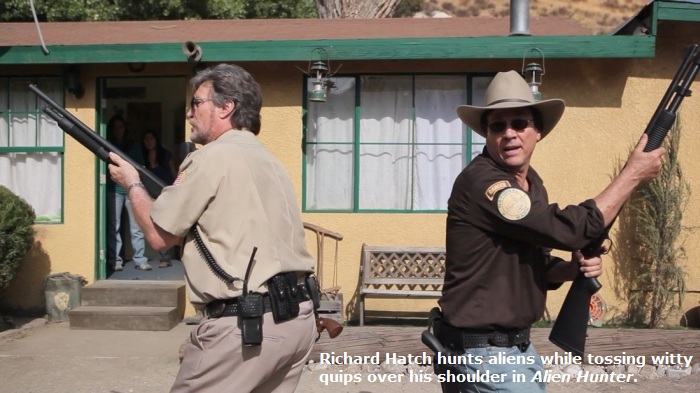
The budget also explains the presence of name actors Richard Hatch and Vernon Wells (whom I especially enjoyed as Plughead in Circuitry Man). "Vernon and I worked together before on The Dead Undead," said Conna, "the first feature I co-directed with Matt Anderson. Vernon let me know he would like to work with me again. Richard's agent heard about Alien Hunger and contacted us. Richard liked the script. We met, got along great, and off we went."
Alien Hunger was shot on several cameras. "The Canon 5D and 7D were used for most closeups. The Panasonic VX200 was used for wide-angle and action shots. We even have some GoPro shots in there. The crashes and action sequences had anywhere from four to nine cameras rolling at once from various angles.
"You can prevent headaches in post-production by working with your post house before principal photography. Before we started shooting, our editor, Nancy Brindley Bhagia, met with Terence Curren at AlphaDogs to establish a workflow." Bhagia used Avid Media Composer "so the footage could be transcoded to DNX 175. This took more hard drive space, but all the footage from the various cameras cut together seamlessly. Avid's Script Sync feature was used for time-aligning the multi-camera clips. The final timeline was sent to Alpha Dogs for color correction and mastering. It was an efficient workflow."

Rather than license the rights to one distributor, who then sublicenses the film to subdistributors in foreign countries, Conna says, "We're being cautious about the deals we are making. To protect our investors, we aren't just 'handing over' the project, and are more involved with it. We are breaking up the various rights and territories. We've had interest from several domestic distributors and had talks with a foreign sales agent who would market to international buyers. Often a film makes money from distribution, but filmmakers receive very little, if any, of it." Conna is working to see that doesn't happen.

|
